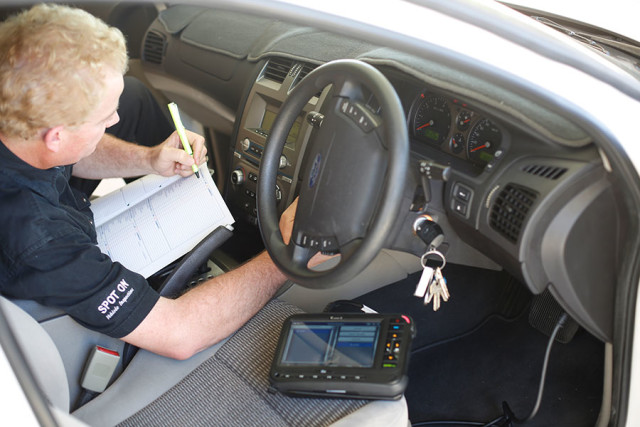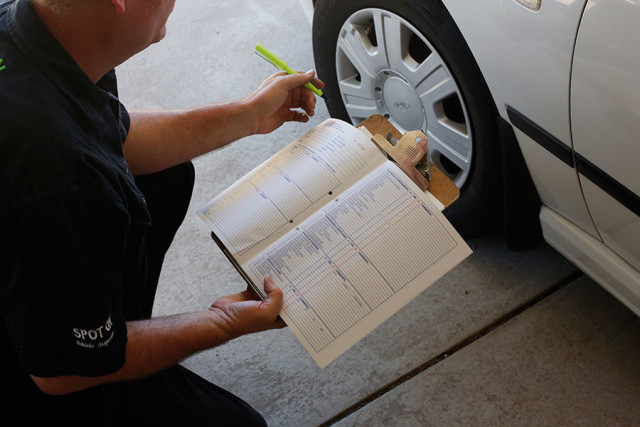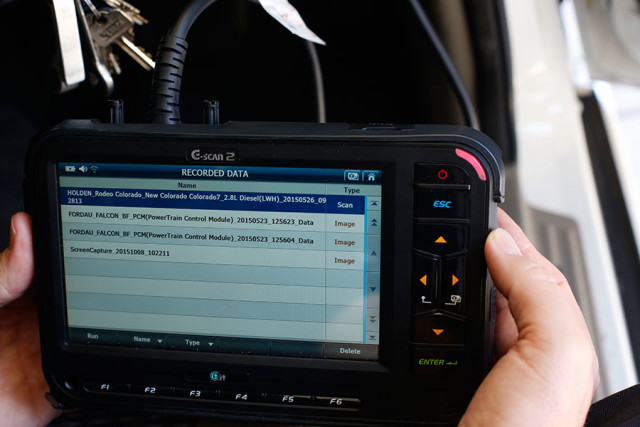Buying a used car is exciting. At first glance, the car you’re looking at buying seems perfect. The body is waxed and shiny, the rims are polished, and they even added that “new car smell.”
But something feels off when you get behind the wheel. The car begins to make questionable noises, clanks when you start it up and shakes when you step on the brakes.
But the good news is, you had the pre-purchase car inspection done before you wasted your hard-earned money on a “lemon,” and you were able to address the issues with the dealership and successfully negotiate a huge discount off the initial asking price.
Below, we’ve listed the five most common problems with used cars and how you can spot them early with a pre-purchase car inspection.
Check for Engine Issues
The engine is a very complex system and requires preventative maintenance. Here are seven warning signs that your engine is having issues:
1 – Your “check engine light” has turned on
The purpose of an activated (lit up) check engine light is to inform you of possible engine trouble. The engine light usually lights up when it senses an issue that has been caused by loss of power. These issues range in severity, type, and implications for your vehicle.
If your check engine light is turned on, you should stop driving immediately and request a tow. A flashing light is a warning that something serious could be present inside one of your vehicle’s systems. Your next step should be to have an engine diagnostic service performed to detect the issue.
2 – Power loss
All gas-powered cars are created with an internal combustion engine. These engines provide the power required to make your vehicle move, by using a four-stroke combustion cycle to turn gasoline into power. The loss of power to your car may be caused by any of these four strokes malfunctioning during the combustion process.
3 – Your gas mileage drops off
If you start to notice that your gas tank doesn’t let you drive as far as it used to, it could be a sign that there’s a problem in the compression stroke of your engine.
A fuel system service or a fuel cleaner may fix the issue. If it has been a long time, a better choice may be a tune-up. If those two options do not help, an engine diagnostic should provide you with the answer to your problem.
4 – Lots of noise
Popping, spitting, hissing, backfiring, and knocking are all sounds you don’t want to hear upon starting your car. These noises can happen if there is an irregularity in the combustion flow. If you hear your engine making any of the sounds mentioned, have your vehicle serviced ASAP!
5 – Your engine stalls
The engine stalling usually means something isn’t right with an engine component. The issue may vary, but most times it’s because the intake stroke is not receiving the right air/fuel mixture or spark. Have this issue seen by a professional ASAP! Stalling can lead to much bigger issues which can easily be avoided by just having a tune-up performed.
6 – The ignition is turned off, but your engine is still running
This issue is also referred to as dieseling or run-on. It’s mostly common with high-performance vehicles and usually happens when there’s an incorrect amount of octane in the gas. Other causes may be an over-active carburetor or a failing solenoid.
Is this issue happening to your vehicle? If so, your local speed shop can provide you with the fix to get your car in perfect condition.
7 – Engine running roughly
If your engine sounds rough, you may just need a tune-up. The common causes of a rough engine are old spark plugs or clogs in the system. Additional issues may be a low battery or incorrect octane in the gasoline.
Check for Hidden Body Damage
There are two common methods to detect hidden body damage.
First, you can check the following areas yourself for potential hidden damage.
1 – Your trunk
A great way to detect rear-end damage is to check if your trunk is still sealing. Try this test: If the inside of your trunk is dry, close it, then spray water at trunk area with a garden hose, and then have a look inside. If water appears inside the trunk, this tells you that the seal is out of alignment, which is an indicator of real damage or a previous accident.
2 – Check the screws/bolts
This tiny clue will actually reveal a lot. Check the screws and bolts used to fasten the trunk lid, doors, and fenders to confirm whether bolts have been turned or paint is broken or chipped. If either of these clues is apparent, this could indicate the screws were removed for body repairs to the vehicle.
3 – Paint inconsistencies
Signs of repainting could be from covering up dents and minor scratches, but it can also be from hiding more serious vehicle damage.
Look for any signs of repainting, like differences in the paintwork or paint on the gaskets or molding. Drag your finger across the inside of the door’s edge and notice if the finish is rough or smooth. Overspray during repainting can cause a rough finish.
You can also use an automotive paint meter to detect hidden rework like filled body panels, respray, and impact damage.
4 – Original Vehicle Identification (VIN) Stickers
Take a look at the vehicle identification number (VIN) on your car’s dashboard to see if it matches the VIN sticker inside the door of your vehicle. If these numbers don’t match, the door has probably been replaced.
The other option is to bring your newly purchased used car to a professional car inspection expert. Not only will this method save you from having to detect all of the above by yourself, but a car inspection expert will be able to inform you of any prior damage, fix any existing damage, and detail the car so that it feels brand new for you.
Check for Pumps, Filters, and Tanks
These three car parts are responsible for jobs like pumping fuel from your gas tank to your engine, preventing harmful debris from entering your engine, and storing flammable gas. So it’s a no-brainer that these parts are worth inspecting.
Fuel pump
The fuel pump’s job is to pump fuel from the gas tank to the engine. Here are some clear signs that the pump is having problems:
- Engine falters at high speeds
- Rising temperature gauge
- Incorrect pressure amount showing in fuel pressure gauge
- Vehicle loses power when under stress
- Your vehicle randomly surges forward while driving
- A noticeable decrease in your gas mileage
- Your engine won’t start
Air filters
Air filters prevent harmful contaminants, dirt, and debris from entering your engine. Common filter problems are:
- Black smoke coming out of the exhaust pipe
- Rough noise coming from the engine
- Backfiring of the engine
- Gas mileage is low
- The exhaust is producing a smell of gas
Gas tank
Your car’s gas tank is a safe container for the flammable gas fluid inside. When compromised, it can cause problems like:
- Rust inside of the fuel tank
- Injector failure
- Lubrication problems
- Shaking while accelerating
- Failure of the fuel pump
- Random engine stalling
- Low mileage and power
Check for Electronics
It’s easy to misdiagnose electrical issues in a used car, so here are the five most common problems:
- The engine is making a “clicking” or “grinding” noise
- Battery issues
- Dysfunctional headlights (and other lights)
- Fuses continue to blow out
- It smells like burning plastic or electrical insulation
Check for Registration
Purchasing a used car does not guarantee that the vehicle’s registration is up to date. There are three common reasons your used car might be part of the Vehicle Registration Withholding Program, and here’s how to fix these issues.
Financial issues
The most common reasons your vehicle might not be approved for registration are usually financial. The previous owner may have neglected to pay for something at some point, like parking tickets or unpaid tolls.
Emissions failures
Sometimes registration may be blocked due to a vehicle’s exhaust. Your car will need to pass a smog and emissions test before you can register or renew the registration. If your vehicle doesn’t pass the test, you’ll need to have the car repaired before it can be registered.
The insurance has lapsed
If the car doesn’t have insurance, you may be blocked from registration.
Conclusion
When we make huge purchases like buying a car, we tend to buy from people we know, like and trust. No one purchases anything with the intention of being ripped off, like being kept in the dark about potential issues regarding your used car purchase. The best way to avoid having the above happen to you is to secure your buy with a pre-purchase car inspection.
At Spot On Vehicle Inspections, our highly trained technicians will perform both an auditory and visual inspection. This will show our technicians tell-tale signs of potential problems. This type of car inspection is especially critical for used cars since most warning signs are not as quickly apparent to untrained eyes and ears.
Book your used car inspection with us today. Just give us a call – 0407 193 506.



